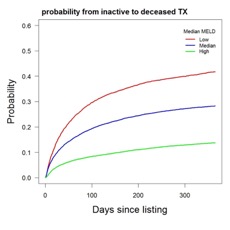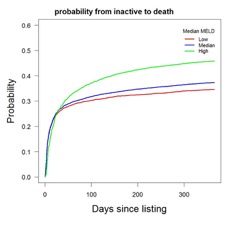Waitlist Mortality and Transplant Probability for Inactively Listed Liver Patients Depends on Donor Service Areas’ Median MELD at Transplant
1Surgery, Yale University School of Medicine, New Haven, CT, 2UNOS, Richmond, VA, 3Yale University, New Haven, CT
Meeting: 2020 American Transplant Congress
Abstract number: B-115
Keywords: Allocation, Liver, Liver transplantation, Mortality
Session Information
Session Name: Poster Session B: Liver: MELD, Allocation and Donor Issues (DCD/ECD)
Session Type: Poster Session
Date: Saturday, May 30, 2020
Session Time: 3:15pm-4:00pm
 Presentation Time: 3:30pm-4:00pm
Presentation Time: 3:30pm-4:00pm
Location: Virtual
*Purpose: Presently, the outcome of patients listed inactive on liver transplant waiting list (WL) are unknown; as inactive patients cannot receive deceased donor organ offers, dynamic prediction of waitlist outcomes to model future transition to active status may provide insights into the known disparities in transplant rates that are observed in the United States.
*Methods: We constructed a multistate model using OPTN database (06/18/2013 to 06/08/2018) to calculate probability of the following competing risks: deceased donor transplant, living donor transplant, death, or WL removal for other/well. MELD exception patients including Status-1 were excluded. We grouped DSA’s by their median MELD at transplant (MMaT) and separated them into tertiles (low, medium, high MMaT DSA). Following an inactive listing, we modelled the future probability of an inactive to active transition and calculated probability of death or transplant.
*Results: Total 25,216 patients of which 378 (1.5%) were listed inactive. If a patient was listed as inactive in a DSA with high MMaT (high DSA tertile), the probability of deceased donor transplant was significantly lower than for patients listed at low and medium DSA tertiles (Fig1.). Higher waitlist mortality was also observed for inactively listed patients from DSAs with a high MMaT compared to low or medium MMaT DSAs (Fig2.)
*Conclusions: Inactive listings for liver transplant represent a small proportion of patients. Yet, there are significant differences in waitlist mortality and the future probability of deceased donor transplant, the latter requiring dynamic prediction to an active state. It is unclear as to why these waitlist outcomes are worse for DSA’s that have a higher MMaT, but it may relate to differences in the management of inactive patients. Whether the underlying cause is a disparity in access to liver allografts or a philosophical difference in waitlist management requires further study.
To cite this abstract in AMA style:
Batra R, Noreen S, Stewart D, Haakinson D, Gan G, Deng Y, Kulkarni S. Waitlist Mortality and Transplant Probability for Inactively Listed Liver Patients Depends on Donor Service Areas’ Median MELD at Transplant [abstract]. Am J Transplant. 2020; 20 (suppl 3). https://atcmeetingabstracts.com/abstract/waitlist-mortality-and-transplant-probability-for-inactively-listed-liver-patients-depends-on-donor-service-areas-median-meld-at-transplant/. Accessed December 18, 2025.« Back to 2020 American Transplant Congress


